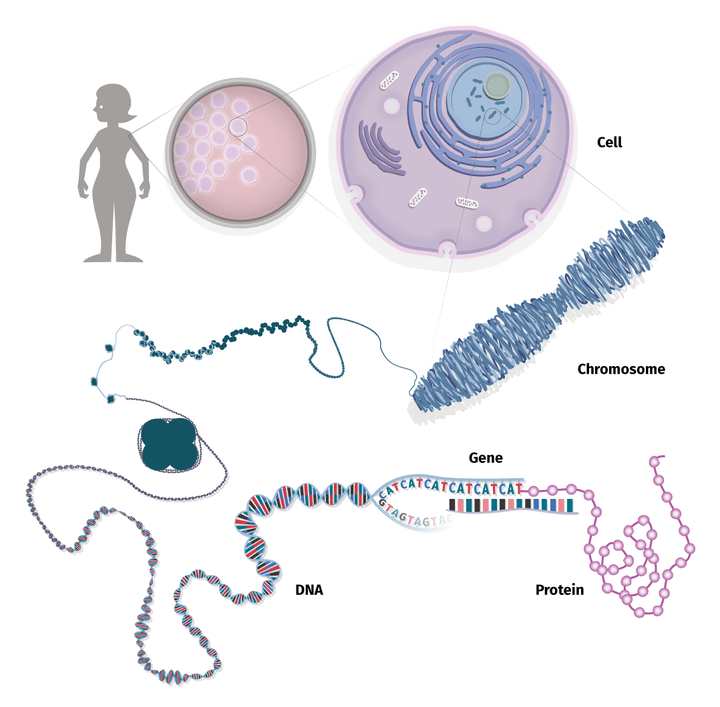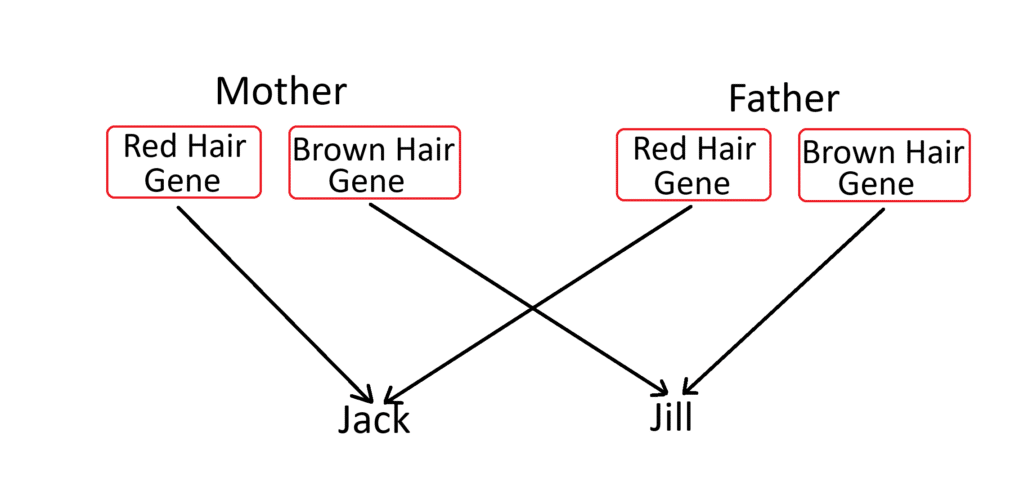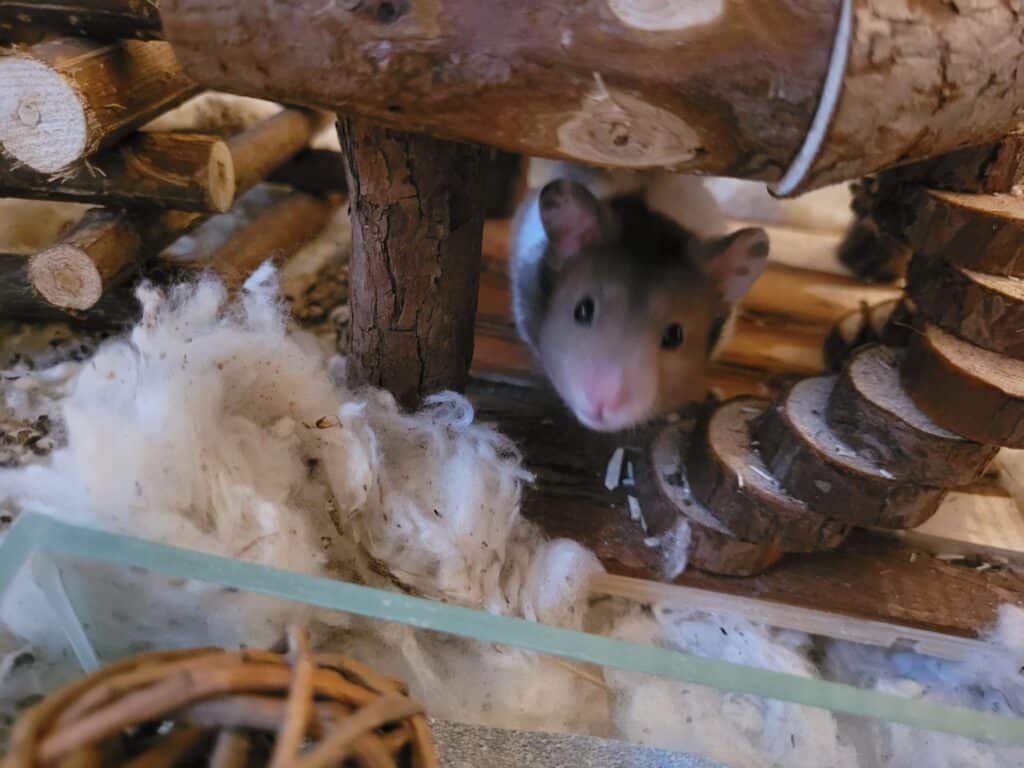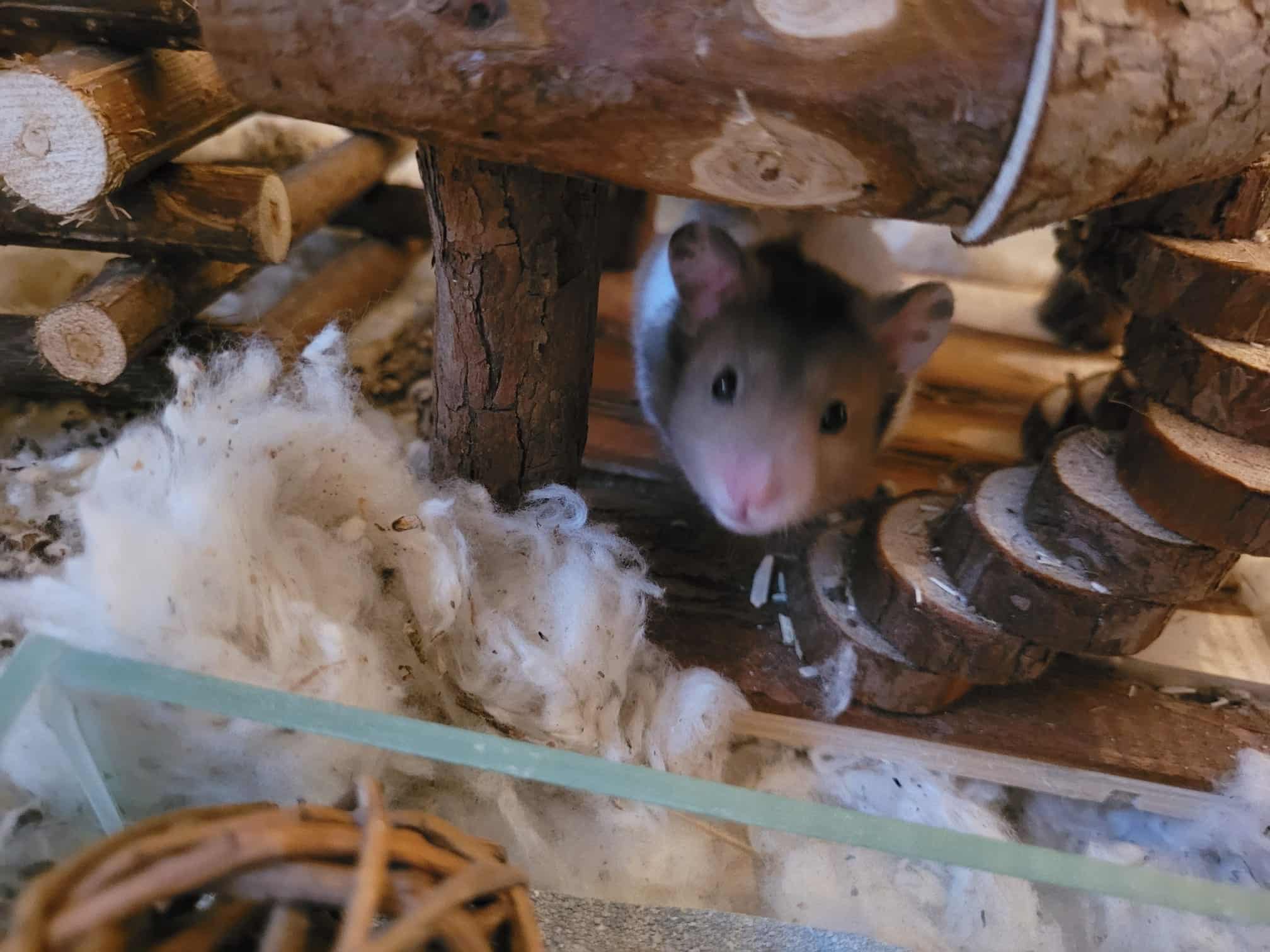Understanding hamster genetics is fascinating. It tells you why your hamster has certain traits – The type of fur, color of coat, color of eyes, etc. It also helps you understand what diseases your hamster is prone to so that you can take educated measures to keep him healthy.
In this blog post, let’s learn about hamster genetics so you can get to know your hamster better and take care of him properly.
Genetics
We all know what genetics is. Genetics is the study of genes and how they are passed down from one generation to the next. Genes carry information that could affect our appearance, health, and even our personality. So, through the transfer of genes, children inherit their parents’ traits (skin color, hair color, eye color, diseases, etc). But how are these information really transferred? Let’s look at it in detail:
Our bodies are made up of billions of cells. Each cell contains chromosomes. Chromosomes always come in matching pairs. The number of chromosome pairs in each cell changes from one animal species to another. In humans, each cell contains 23 pairs of chromosomes for a total of 46 chromosomes. In each of these pairs, one chromosome comes from one parent and the other from the other parent, i.e., we get 23 chromosomes from our mothers and 23 chromosomes from our fathers.
The first 22 chromosome pairs are called Autosomes. The last pair is the sex chromosome. If two X sex chromosomes are present, the child will be a girl; if an X and a Y are present, the child will be a boy.
Each chromosome contains one DNA molecule. Each DNA molecule is comprised of hundreds to thousands of genes, which are the functional parts of the DNA molecule. The genes are arranged in a specific order along a DNA molecule (Source: The National Library of Medicine, USA).

Like chromosomes, genes also come in matching pairs. Each parent passes on one gene from the matching pair to their offspring. So, we get half of our genes from our mothers and the other half from our fathers. The genes (and chromosomes) that are passed on to us determine our physical traits, like the color of our hair, skin, eyes, etc., as well as health conditions, like diabetes, etc.
For example, if Jack and Jill’s mother has one gene for red hair and one for brown hair and passes on the red hair gene to Jack and the brown hair gene to Jill, and their father has one gene for red hair and one gene for brown hair and passes on the red hair gene to Jack and brown hair gene to Jill, Jack would have red hair, and Jill would have brown hair.

Now that we understand what genetics is, let’s look at hamster genetics and how it helps bring variety into the hamster gene pool.
Hamster genetics
Genetic studies on hamsters have identified the specific genes responsible for the traits of hamsters like coat color, coat pattern, hair length, eye color, etc. Using this information, hamster breeders have been selectively breeding hamsters not only to produce offspring with desired traits but also to create new variations in the aforementioned traits which don’t survive in the wild.
For example, Syrian hamsters (Mesocricetus auratus) only have gold-colored coats and short hair in the wild. All other variations do not tend to survive since they are less adapted to the environment. However, in captivity, hamsters with unusual characteristics can be protected from predators, and their traits can be preserved by breeding.
Hamster genetics also helps us maintain the health and quality of different hamster breeds by identifying and eliminating variations that produce offspring with uncommon diseases and short lifespans.
Factors behind a hamster’s coat and eye color
Among all pet hamster species, Syrian hamsters portray an incredible diversity of coat colors and types. This diversity is brought about by the mutations that occur in the genes behind their coat traits.
What is mutation?
When a cell splits into two, the DNA and the chromosomes it contains are copied exactly to its daughter cells. Therefore, almost all the cells of your hamster contain copies of the exact same DNA. However, at times, an error can occur in this copying process, which alters a gene, giving rise to an allele. This is called a mutation.
When a mutation occurs in germ cells (the cells that later become sperms and ova), this mutation can be passed on to the offspring.
Hamsters have 22 pairs of chromosomes. Of these, 21 are autosomes, and the last pair is the sex chromosome. Each chromosome can contain hundreds to thousands of genes. Of these genes, only 21 have been identified that affect the appearance of hamsters (Coat pattern, color, and type – More on this later).
What is an allele?
Alleles are different versions of a normal gene produced due to gene mutations (Source: Technology Network). As we saw before, genes can affect the physical traits of an organism and always come in pairs (one in each paired chromosome). So, in a gene pair that controls fur color, one allele (gene form) may code for brown, and the other may code for white (if a mutation had occurred somewhere in the lineage of that hamster).
There are two types of alleles – Dominant and Recessive alleles – that determine what is passed down to offspring and what is not.
What is a dominant allele?
A dominant allele is an allele that overrides or masks the effect of its paired allele, thereby controlling the visible aspects of a hamster’s physical appearance.
Different coat types are observed in Syrian hamsters, like long-haired, short-haired, rex, and satin. Dominant alleles can contribute to the development of these coat types as well as determine if the coat is wavy or curled.
Dominant alleles can also determine which coat pattern a Syrian hamster has – Dominant Spot, Banded, Tortoiseshell, Tortoiseshell and White, or Roan.
Coat colors can also be influenced by dominant alleles.
In genetics, each gene is assigned a letter of the English alphabet. The symbols for dominant alleles are capitalized, indicating that to affect the appearance of a hamster, just one copy of that allele is sufficient.
What is a Recessive allele?
A recessive allele is an allele that gets masked by a dominant allele. Therefore, it does not show its effect in an organism if it is paired with a dominant allele. If one parent has a dominant allele and the other has a recessive allele, the dominant allele will mask the effect of the recessive allele. So, only the effect of the dominant allele will be visible.
The symbols for recessive alleles are written in lower case, indicating that to affect the appearance of a hamster, that allele must be present in both chromosomes.
Understanding Dominant and Recessive alleles using an example
Let’s consider a Syrian hamster. The Rust gene is indicated using the symbols bb (‘b’ for brown) and golden color gene (in this case) as BB. It means that the gene responsible for the brown color is mutated in a Rust hamster, whereas in a wild golden hamster, the same would be unmutated. Moreover, the dominant unmutated gene gives rise to golden color, whereas the recessive mutated allele gives rise to a rust color.
Let’s see how a rust hamster is born.
In the wild, the gene responsible for the Brown color in gold hamsters is a dominant gene. So, this gene is represented by the symbol BB. Let’s assume that one day, a mutation occurs in one of the gene pairs in one of the hamsters. Then, the gene becomes Bb.
When this hamster mates with a normal gold hamster, this gene pair (Bb) has a 50% chance of being passed down to the offspring but will not produce any change in appearance since rust is a recessive gene and needs another recessive gene to produce a change in appearance. So, in a litter size of four, the following can happen:
BB (Golden) x Bb (Golden) = BB (Golden) + BB (Golden) + Bb (Golden) + Bb (Golden)
If these pups are interbred, there is a 25% chance for a rust-colored pup to be born:
Bb (Golden) x Bb (Golden) = BB (Golden) + Bb (Golden) + Bb (Golden) + bb (Rust)
Now, when two such Rust hamsters are bred, the pups have a 100% chance of being rust.
bb (Rust) x bb (Rust) = bb (Rust) + bb (Rust) + bb (Rust) + bb (Rust)
On the other hand, when you cross a rust with a golden hamster, all the offspring will be 100% golden, carrying the recessive b allele.
bb x BB = Bb (Golden) + Bb (Golden)+ Bb (Golden) + Bb (Golden)
Common Coat colors Found in Syrian Hamsters
Based on their coat color, Syrian hamsters can be categorized into three main groups: self-colors, agouti markings, and combinations (Source: Wikipedia).
Self-colors are fur with a consistent coat color. The topcoat and undercoat have the same color, but the feet and chin are white and white chest and belly patches can be present.
Agouti markings are characterized by a ticked coat, i.e., the fur is banded in different colors. Agouti hamsters have a light underbelly and dark markings on the head and cheek.
Combination coats are produced when more than one self or agouti colors are present, i.e., when two or more genes are expressed at the same time.
Mutations in Syrian hamsters that affect the coat (color, length, etc.)
| Mutation | Symbol | Wild type Gene pair | Mutated Gene pair |
| Melanistic black | a | AA or Aa | aa |
| Rust | b | BB or Bb | bb |
| Banded | Ba | baba | BaBa or Baba |
| Dark eared White (Acromelatic gene) | cd | CC or Ccd | cdcd |
| Extreme dilute | ce | CC or Cce | cece |
| Dark grey | dg | DgDg or Dgdg | dgdg |
| Dominant Spot | Ds | dsds | Dsds (dsds die in womb or after birth) |
| Black eyed cream | e | EE or Ee | ee |
| Hairless | hr | HrHr or Hrhr | hrhr |
| Longhaired / Angora / Teddy bear | l | LL or Ll | ll |
| Light grey | Lg | lglg | Lglg (LgLg die in womb or after birth) |
| Cinnamon | p | PP or Pp | pp |
| Recessive dappled | rd | RdRd or Rdrd | rdrd |
| Ruby eyed | ru | RuRu or Ruru | ruru |
| Rex | rx | RxRx or Rxrx | rxrx |
| Piebald (Spotting) | s | SS or Ss | ss |
| Satin | Sa | sasa | SaSa or Sasa |
| Silver grey | Sg | sgsg | SgSg or Sgsg |
| Yellow | To | toto, toY | ToTo, Toto, ToY |
| Umbrous | U | uu | UU or Uu |
| Anaphthalmic White | Wh | whwh | WhWh or Whwh |
Different breeding techniques used by hamster breeders
There are two steps followed in breeding. In the first step, Selection, the individuals to be used for breeding are carefully selected so that only the genes of the best individuals are passed to the offspring. In the second step, Crossing, the selected individuals are paired to produce the best offspring.
There are several ways the individuals can be chosen for Crossing:
- Inbreeding – In this method of breeding, first-degree relatives are crossed to produce offspring with desired traits. It can further be divided into Sibling Cross (Crossing a brother and sister) and Backcross (Crossing a parent and an offspring)
- Line breeding – In this method of breeding, two distant relatives are paired, like grandparent and grandchild, aunt and nephew, cousins, etc.
- Outcrossing – In this method of breeding, two totally unrelated individuals are paired.
Most of the genes that give rise to genetic defects and disorders are recessive by nature. So, as you can see, of the above breeding techniques, outcrossing is the only safe method of breeding hamsters because it reduces the chances of two hamsters with the same recessive gene breeding and giving birth to hamsters with defects. It is also the only ethical way to breed as well. However, it is a slow process.
So, many commercial breeders, like breeding mills and farms, often use Inbreeding and Line breeding techniques to breed hamsters, which can give rise to hamsters with birth defects. Female hamsters in these places are also overbred, without having enough time to recuperate between pregnancies. These breeders often interbreed hamsters to produce the required trait without considering the hamster’s safety.
How can you prevent unethical breeding practices?
Buy hamsters from recognized ethical breeders or rescue centers. To find out if someone is an ethical breeder, ask them about the hamster’s lineage. They should be able to show you the photos of their parents. Ethical breeders who use safe practices will not use hamsters from pet stores to breed because they most likely come from breeding mills or farms. Moreover, ethical breeders will not charge more for rare colors, because money is not (normally) the goal for them, but creating a healthy, diverse hamster gene pool.



